|
|
 |
|
KATARXIS N°2
|
 |
|
Seaside Chapel
|
 |
|
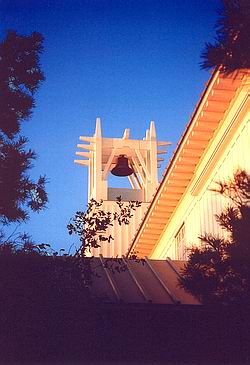
Seaside Chapel, Seaside, Florida
by Scott Merrill and George Pastor
The contemporary western world might be dominantly
secularized, and New Towns are not faith communities nor organized around "religio" as a fundamental dimension of urban life,
as have been antique and medieval cities, and quite often European and American towns until
recently. However the religious and spiritual aspirations of contemporary urban and suburban communities, and generally
their intense demand for a spiritual focus in their private and civic lives, remains an intriguing reality.
Though churches and temples still have
predominant presences in most historic cities, faith and religious practice have undergone substantial mutations and generally
the influential role of religion in the ceremonials of public life, in the shaping of the urban communities' identities,
and in their spiritual guidance has dramatically decreased in the postwar decades.
In a world where spirituality is in hard
competition with a hedonistic consumerism, and where a lot of heretic ecclectism and exalted pagan revivals, occult
speculations and shamelessly vicious religious sects challenge institutionalized churches and established faith communities,
the reevaluation of the "res sacra" in the city must be of a particular importance, despite, and maybe, because of a
critical spiritual and religious frustration.
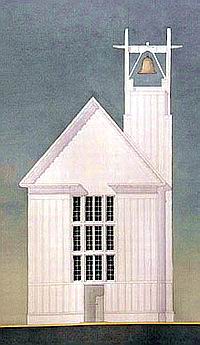
Seaside Chapel, Main Elevation
by Scott Merrill and George Pastor
The Sacred and Architecture
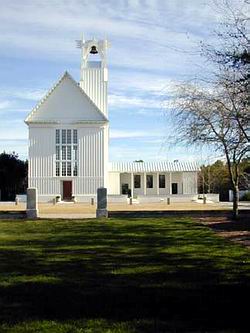
Seaside Chapel, Seaside, Florida
by Scott Merrill and Georg Pastor
(Photo by Philip Bess)
|
 |
|
|
"Do we impress the God who spoke the heavens
and earth into existence by our lofty domes or our "dramatic" modulation of light? God's presence is not intrinsically greater
at Chartres cathedral than it is at the humblest country chapel, or even at the muffler shop. Nor does God require any particular
building type to meet with his creatures."
David Gobel

Seaside Chapel, Interior Sketch
by Scott Merrill and George Pastor
"Nor does God require any particular building
type to meet with his creatures. House /Temple, basilica, tholos, none of these are inheretly more sacred, none belong to
the church per se (nor to any denomination). Similarly, human traditions, --though we are tempted to venerate them--, are
not divinely inspired.
The inability of architecture to become
sacred absolves neither church meeting houses, nor muffler shops from their civic and divine responsibility, to be built with
due regard for tradition, decorum and beauty. In this context, the meeting house will invariably have a greater dignity than
the shop."
David Gobel
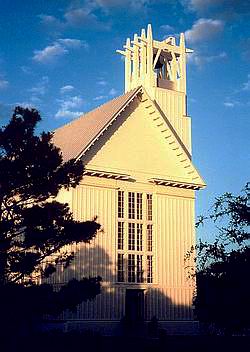
Seaside Chapel, Seaside, Florida
by Scott Merrill and Georg Pastor
(Photo by Scott Merrill and Georg Pastor)
"The 'church', properly speaking, is
never a building. In its earthly form, it is the assembly of God's people. But it is also a civic institution.
God can meet with his people and Christ can be truly present among a congregation meeting in a muffler shop
or a suburban mega-church (even one with a Starbucks inside).
But given the choice, the local church ought to build meeting houses that accomodate the worship of God
in a commodious and dignified manner, and represent their status as a civic institution in a way that promotes the common
good, and bears witness to Christ the king.
To do so out of a tradition or understanding of typology is a folly and shows disregard for one's neighbour.
A well-designed, well-built church meeting house might even give delight and cause us to give thanks to our creator who gave
skill to the builders, and who is the author of all beauty."
David Gobel
(These quotes by David Gobel,(a professor at the
Savannah College of Arts and Design), are taken from a letter: "Non-denominational Churches", posted on Tradarch List,
University of Miami )
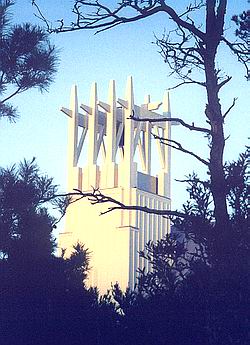
Seaside Chapel, Bell-Tower Detail
by Scott Merrill and George Pastor
(Photo by Scott Merrill and Georg Pastor)
|
 |
|
|
 |
|
|
 |
|
|
|
 |
|
|
|
New Urban Communities
New towns, resorts and developments are
not parish villages or church communities...They are in the best of cases an adequate synthesis of a complex socio-cultural
pattern and of a complex urban armature.....
Fresh New Urban communities are often characterized by an ecclectic diversity, solidary however within the
common vision of a new urban conviviality, the principles of which refer to the best examples of historic cities, both American
and European!
Even if these communities might be seasonal or in a formative stage, it remains that they can rely , --for
identification and representation--, on the clearly articulated pattern of the town, the clear hierarchy of
its buildings and spaces, the familiarity of its architectural character imbedded in a refreshed interpretation of local traditions
of architecture and construction, the ideals of permanence as expressed in its civic monuments...
It is actually by this support of a clearly stated typological articulation of a community in its public
buildings and spaces, its monuments and parks, and generally in the layout and typological appropriateness of the
town's urbanism, that a living community can develop a rich and complex urban life urban life in its profane
and sacred aspects, fostering the community's aspirations towards higher ideals of spiritual life and religious communion.
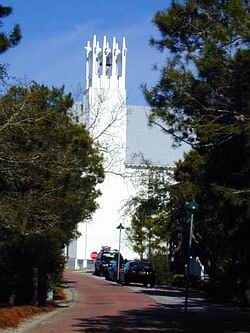
Seaside Chapel, Seaside, Florida
by Scott Merrill and Georg Pastor
(Photo by Philip Bess)
In this context, both Leon Krier's Meeting-Hall
in Windsor and the Seaside Chapel by Merrill&Pastor provide appropriate opportunities of communal focus and adequate
civic settings to celebrate transcendant ideals and the virtue of 'religio'.
Their monumental exceptionality and identifiable civic character, their typological and symbolical definition,
the correctness of their location and of their urban integration, etc., stimulate and support the socio-cultural and spiritual
cohesion of the urban community as an intrinsic part of the New Urban Civitas!
|
|
